
Fad diets seem to be popping up in greater numbers these days. And yet, obesity levels have been on the rise globally, nearly tripling since 1975, according to the World Health Organization. With all the varying nutrition information out there, it can be hard to know what is healthy and what is not.
Although certain foods like dairy, eggs, and fats are contentious topics in the nutrition world — often with conflicting scientific evidence of their health benefits versus dangers — there is a consensus around the health of foods such as whole grains and vegetables.
24/7 Tempo compiled a list of healthy eating habits that will change your life, based on the science behind these foods and choices. We consulted multiple health journals, including Harvard Health Publishing, as well as numerous scientific studies published in The United States National Library of Medicine.
Whole foods — such as unprocessed grains, fresh fruits and vegetables, and fresh fish — are healthy staples in most diets, as opposed to processed foods and snacks that often contain high amounts of sodium and sugar — essentially calories empty of much or any nutritional value. Here are 27 top ways to cut sugar and boost your health.
Click here for healthy eating habits that will change your life

1. Prepare meals from scratch whenever you can
When you cook for yourself using whole, fresh ingredients, you can monitor your sodium, sugar, and fat levels — something that is difficult to do when you eat out or buy prepared food. Preparing meals at home is also cheaper than eating out.
Besides ensuring that you get adequate nutrition, preparing meals from whole foods may also impact your mood. Studies have suggested a possible link between eating heavily processed foods — such as fast food and processed baked goods — and an increased risk of depression. Other studies, alternately, suggest that diets high in vegetables, whole grains, fruits, and fish may be associated with reduced risk of depression. More studies, however, are needed on the link between depression and diet.
[in-text-ad]

2. Eat smaller portions (on smaller plates)
Restaurant portions are often enough for two or three people. Control your portion size by ordering an appetizer or a small plate instead of an entree, or by sharing an entree with a friend.
At home, serve meals on small plates, which can make your portion feel larger. Studies have shown that people are more likely to overeat when they are eating from larger plates.

3. Avoid sugary drinks (including fruit juice)
Daily drinking of sugary drinks such as soda and fruit juice increases the risk of obesity, type 2 diabetes, and heart disease. In addition, the fructose in these drinks does not make the body feel full, so soda drinkers tend to consume more total calories than those who do not drink soda.

4. Drink coffee (in moderation and without sugar)
Coffee drinking is associated with lower risk of type 2 diabetes, and may be associated with lower risk of dementia, and Alzheimer’s, although adding sugar can negate some of the health benefits.
While drinking too much coffee can cause anxiety and insomnia in some people — largely depending on genetics — a recent study out of Linus Pauling Institute, Oregon State University, suggests that for adults consuming three to four cups of coffee per day, “there is little evidence of health risks and some evidence of health benefits.
[in-text-ad-2]

5. Plan meals and make extra for leftovers
Meal planning helps you keep an eye on nutrients and ensure you are getting a well-balanced diet. Plan a few meals a week around recipes you and your family like, and shop for those ingredients.
It sounds like a no-brainer, but how many times have you been caught hungry with an empty fridge and ended up ordering delivery or going out to eat? Make enough food to have leftovers for another day or two and you’ll only need to cook two or three days a week.
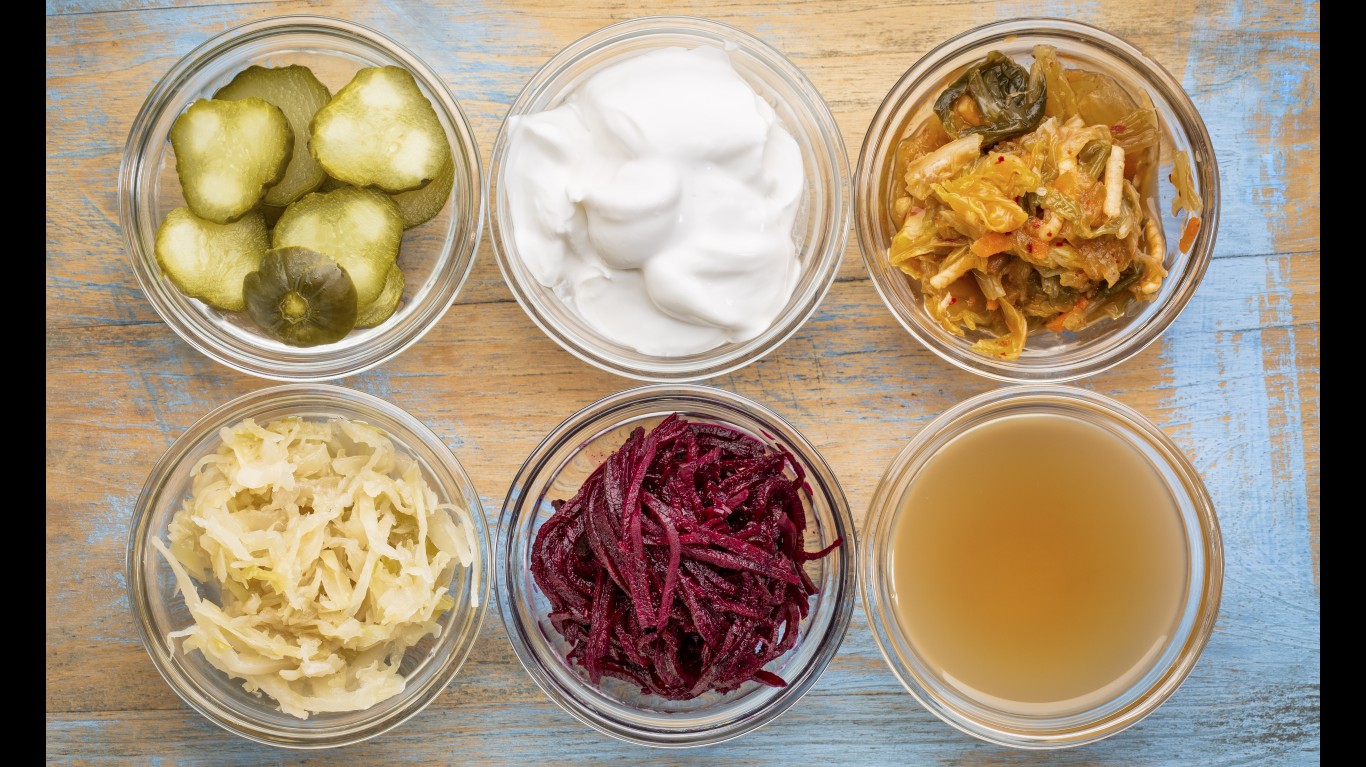
6. Tend to your gut health with fiber and probiotics
The bacterial colony in your intestines, called your gut microbiota, is intricately connected to your mood, immune system, and propensity for chronic inflammatory diseases and obesity.
Two great ways to keep your microbiota healthy are eating sufficient dietary fiber and eating probiotics, either in the form of dietary supplements containing active cultures, or by eating fermented foods such as yogurt and sauerkraut. It is important to note that more studies are needed on how probiotics can improve gut health.
[in-text-ad]

7. Don’t fear all fats
The notion that eating fat makes you fat is outdated. What might make you fat is choosing low-fat foods that contain high amounts of refined carbohydrates.
Your body needs fat to function and absorb nutrients, and essential fatty acids, particularly omega-3s, are crucial to proper brain function. Unsaturated fats, such as those found in olive oil, nuts, seeds, fish, and avocados are considered healthy. The trick is to avoid trans fats and limit saturated fats intake.

8. Eat more whole fruits and vegetables
A diet high in fruits and vegetables is associated with lower risks of cancer, heart disease, stroke, and diabetes. A new study also suggests that eating more fruits and vegetables may benefit psychological health as well.

9. Drink water, especially before meals
The importance of drinking water cannot be overstated. It keeps the kidneys functioning — and helps prevent kidney stones — while also preventing constipation and dehydration.
It is also associated with weight management. Replacing sugary drinks such as soda with water can lead to less calorie consumption, and some studies suggest that people who drink water before meals may consume less calories and also lose weight more readily.
[in-text-ad-2]

10. Consider nutrients instead of counting calories
Reducing daily eating patterns to a calorie count overlooks the fact that certain foods contain empty calories with little nutritional value. Some food options contain a significant amount of nutrients per ounce and are more satiating, which may help you consume less calories at the end of the day.
Take nuts for example: they contain fiber, which helps you feel full immediately, and protein, which helps you feel full for longer. Rather than counting calories, focus on eating high-quality foods such as whole grains, vegetables, and healthy protein sources.
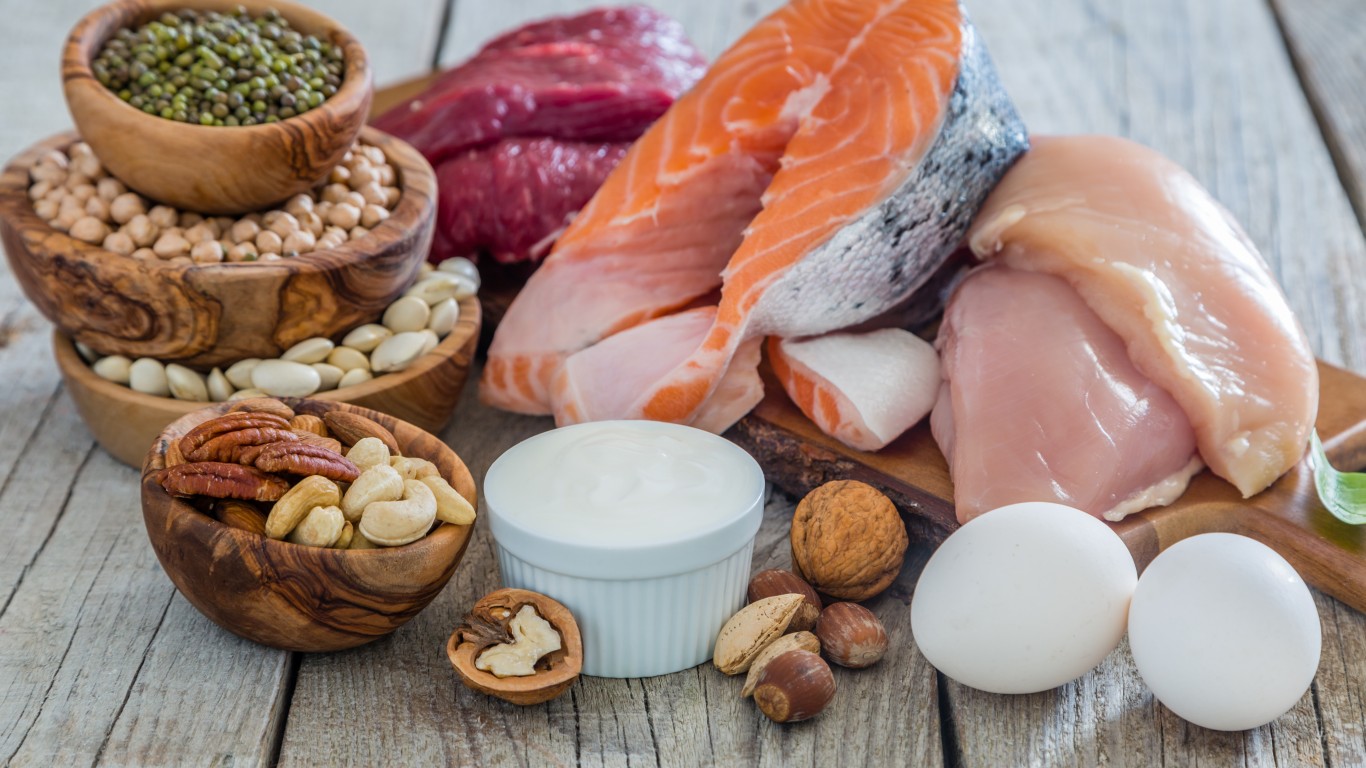
11. Eat a variety of proteins
Protein is essential to any diet, and luckily, proteins are easy to get from animal and plant sources. Proteins are made from amino acids, and nine of these — called essential amino acids — are the ones that the human body cannot produce and must ingest from food.
Eating a variety of plant protein sources, including legumes, nuts, seeds, and whole grains can provide the full range of these essential amino acids. Poultry, fish, and eggs are considered to be the healthier animal sources of protein than red meat and dairy.
[in-text-ad]

12. Eat less salt
High sodium intake can lead to high blood pressure and heart disease. Because most of the sodium we ingest comes from commercially prepared foods, as opposed to home-cooked meals, it is important to read labels on pre-packaged foods and monitor sodium intake.
According to the CDC, the top sources of sodium in American diets are breads, pizza, savory snacks such as potato chips and crackers, sandwiches, cured meats including lunch meat, soups, tacos and burritos, eggs, chicken, and cheese.

13. Don’t fear eggs, but don’t overdo it
The 2015-2020 dietary guidelines for Americans recommend eggs as a nutrient-dense protein source. Many studies have shown that consumption of up to one egg a day is not associated with increased risk of heart disease in healthy individuals who are not diabetic.
A 2019 study, however, shows a correlation between higher consumption of dietary cholesterol, including eggs, and higher rates of coronary heart disease. This risk was linked to eating, on top of a regular diet, three to four eggs or 300 mg of dietary cholesterol per week.

14. Shop with a list
Grocery store layouts are designed to sell you more products than you intend to buy, whether or not they are healthy. This is where a shopping list might come in handy.
A study of Pittsburgh area shoppers considered at high risk of having a poor diet found that using a grocery list was associated with a healthier overall diet and a slightly lower body mass index.
Stick to your list and resist impulse buys. A 2018 consumer survey found that people spent an average of $450 a month on impulse buys, with 70% of people reporting that food was their main impulse purchase.
[in-text-ad-2]
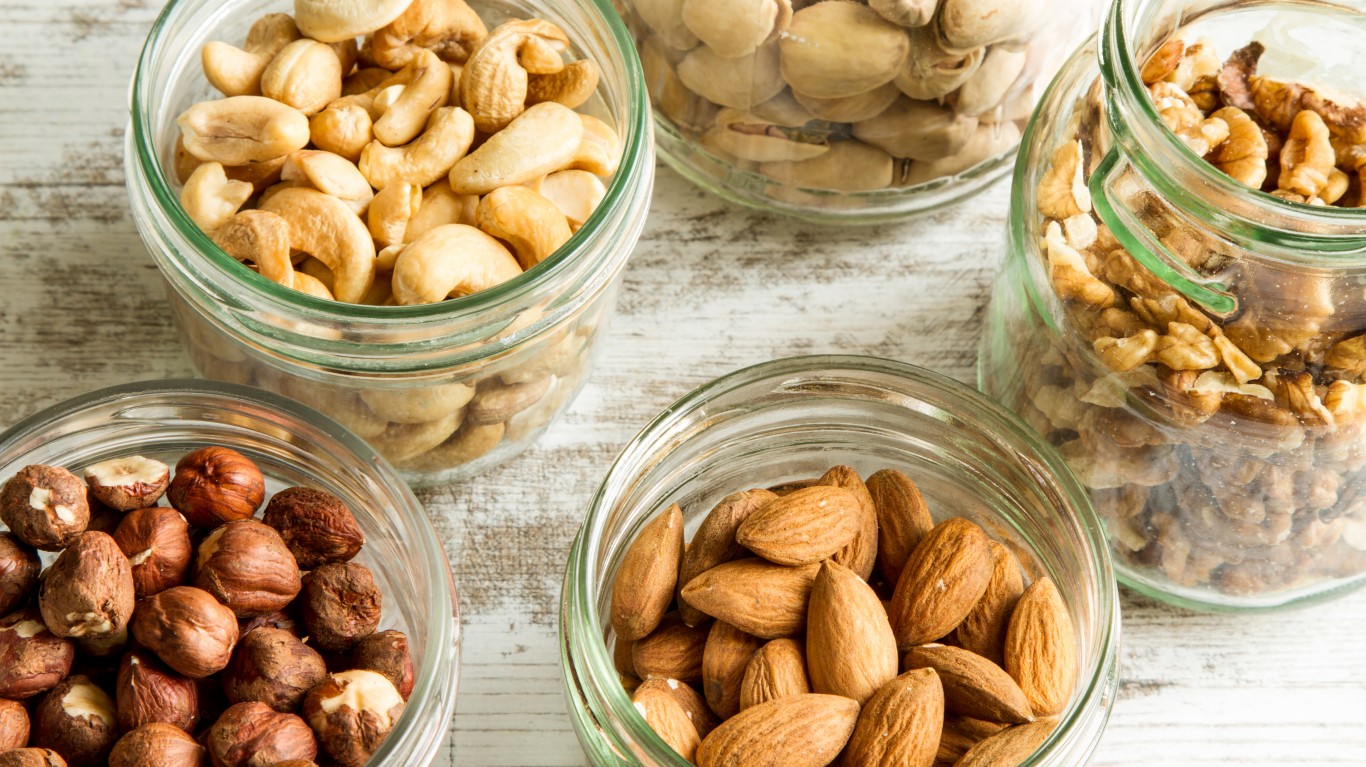
15. Instead of processed snacks, snack on nuts
Keeping a container of nuts in your car or purse can help prevent unhealthy snack purchases and even reduce the risk of weight gain. A new study suggests that regularly snacking on small amounts of nuts may prevent excessive weight gain and lower the risk of obesity.
Nuts contain protein, fiber, and healthy fats, all of which help you feel full for longer.
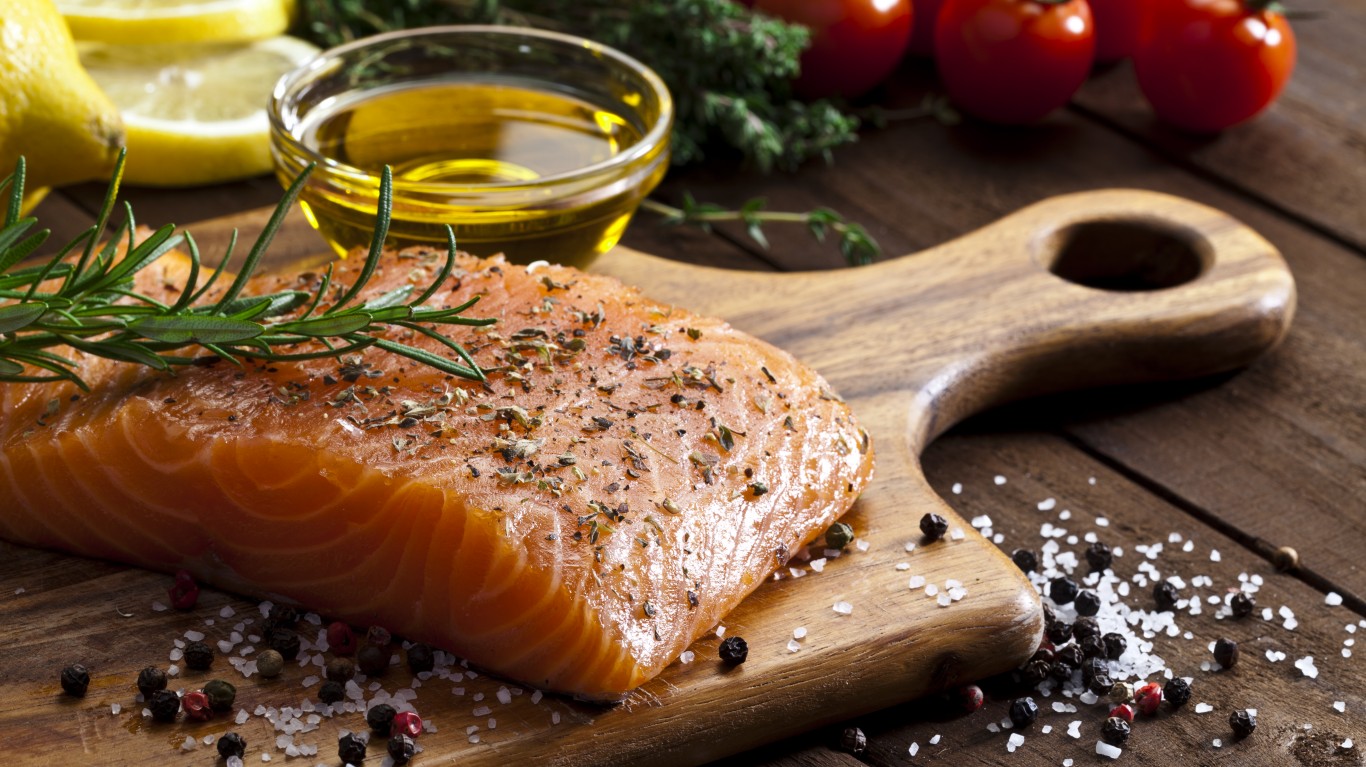
16. Consume fatty fish
The American Heart Association recommends eating two servings of fish — especially fatty fish such as sardines, salmon, herring, albacore tuna, and lake trout — per week. These fish are high in protein as well as omega-3s, which contribute to heart health.
The FDA further advises to avoid fish that are high in mercury such as shark, king mackerel, swordfish, and tilefish.
[in-text-ad]

17. Limit high-glycemic index foods
Although all carbohydrates are converted into glucose in the body, some are converted much faster than others, causing blood sugar levels to spike. The glycemic index ranks carbohydrates on how quickly and how much they increase blood sugar levels. Eating high-glycemic foods such as white bread and refined sugars can increase your risk of type 2 diabetes and heart disease.
Foods that are high in fiber, such as whole grains, broccoli, beans, and apples with their skin on take longer to digest and therefore the converted sugar is released slower into the blood. Foods with their fiber removed, such as white flour, are higher on the glycemic index.
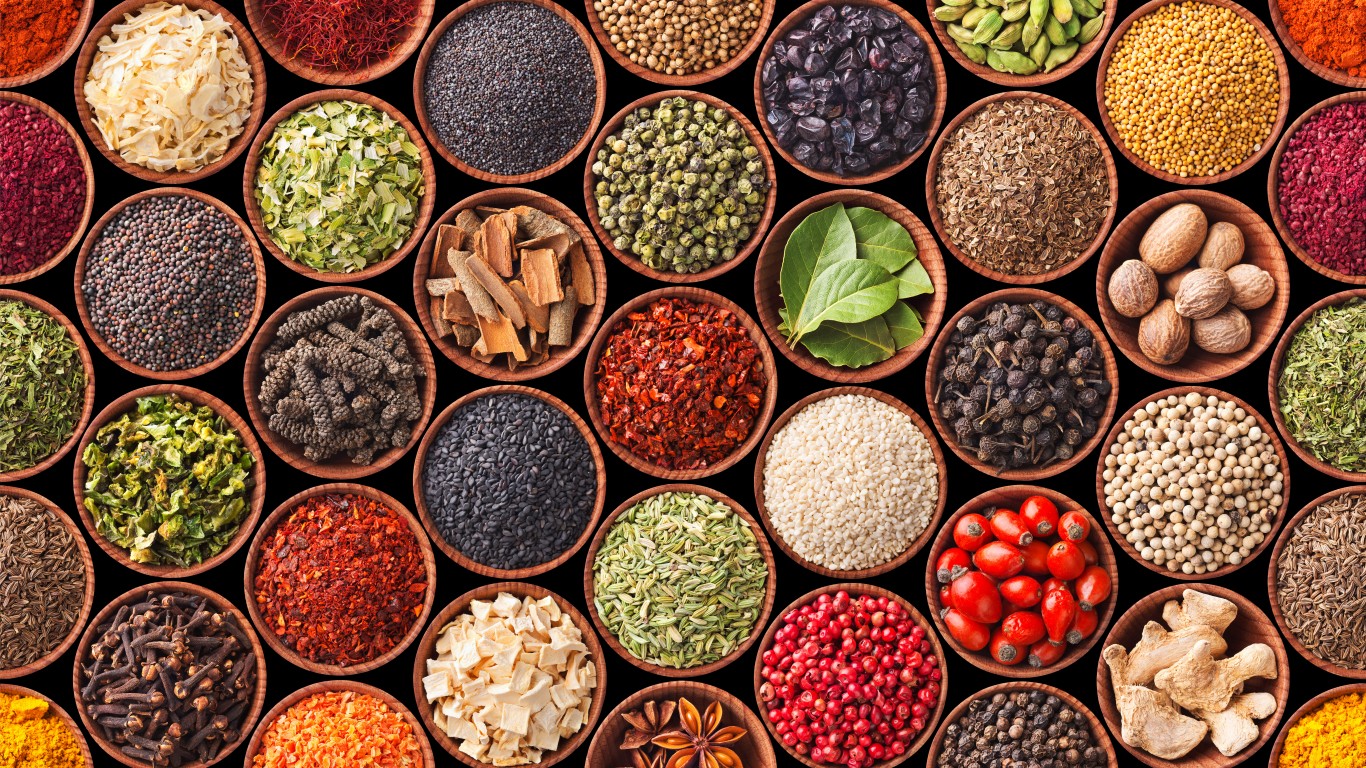
18. Use more fresh herbs
Not only is using fresh herbs an easy and cheap way to make everyday foods interesting, it is also a great way to increase your nutrient intake. Leafy herbs such as dill, parsley, and basil are nutritionally similar to other leafy greens, such as spinach, and may contain vitamins A, C, and K.
While herbs are often used dried in small amounts as a seasoning, they can also be used fresh in large quantities. Try adding diced chives to an omelet, loading cilantro on to tacos, or putting a handful of fresh basil into soup before serving.

19. Pay attention to your body
How often do you feel tired or have an upset stomach after eating? Stress, multitasking while eating, having a food intolerance, or not chewing food thoroughly can all lead to indigestion or discomfort. Notice how you feel after you eat. Do certain foods always upset your stomach? If so, you may need to get an allergy test. The first step toward better digestion is simply noticing what happens in your body after you eat.
[in-text-ad-2]

20. Ensure you’re getting enough vitamin D
A 2011 analysis of U.S. adults found that 41.6% were vitamin D deficient. Vitamin D is crucial to bone health, and deficiency may be linked to increased risk of heart disease and cancer. Dietary sources include certain fish and fish liver oils, egg yolks, UV-treated mushrooms, and fortified dairy and grains.

21. Eat slowly
While there are no studies proving the common narrative that it takes 20 minutes for our brains to register that our stomachs are full, there is most likely a lag, as partially digested food and nutrients must enter the small intestine before digestive hormones are released to signal to the brain to stop eating.
In theory, eating too quickly might not give this hormonal feedback system adequate time to relay satiety to the brain. A study published in the Journal of the American Dietetic Association concluded that although further study is needed, eating slowly may help people feel more full and eat less calories.
[in-text-ad]

22. Keep healthy foods at home, so you don’t reach for junk foods
A 2018 study of online food choices suggests that unhealthy food options may be more influential than healthy options. The researchers concluded that compared to adding healthier options, removing less healthy food options could have a greater impact on healthier choices.
If this is true, then it is a good idea to keep only healthy foods stocked and avoid bringing home junk food. A bowl of fruit, vegetables, and hummus, or a jar of nuts within easy reach can healthily fulfill snacking urges.

23. Limit grilled and fried meats
Heating meat to high temperatures, especially if frying or grilling it over an open flame, can cause the formation of chemicals that cause changes in DNA and may increase cancer risk. Smoke also increases the amount of these chemicals in meat.
An easy way to avoid ingesting these potentially cancerous compounds is to poach, roast, braise, or stew meat and avoid burning it or exposing it to direct flame or smoke. If you are going to grill, consider partially cooking it before putting it over the flames and use leaner cuts to avoid fat dripping into the flames.
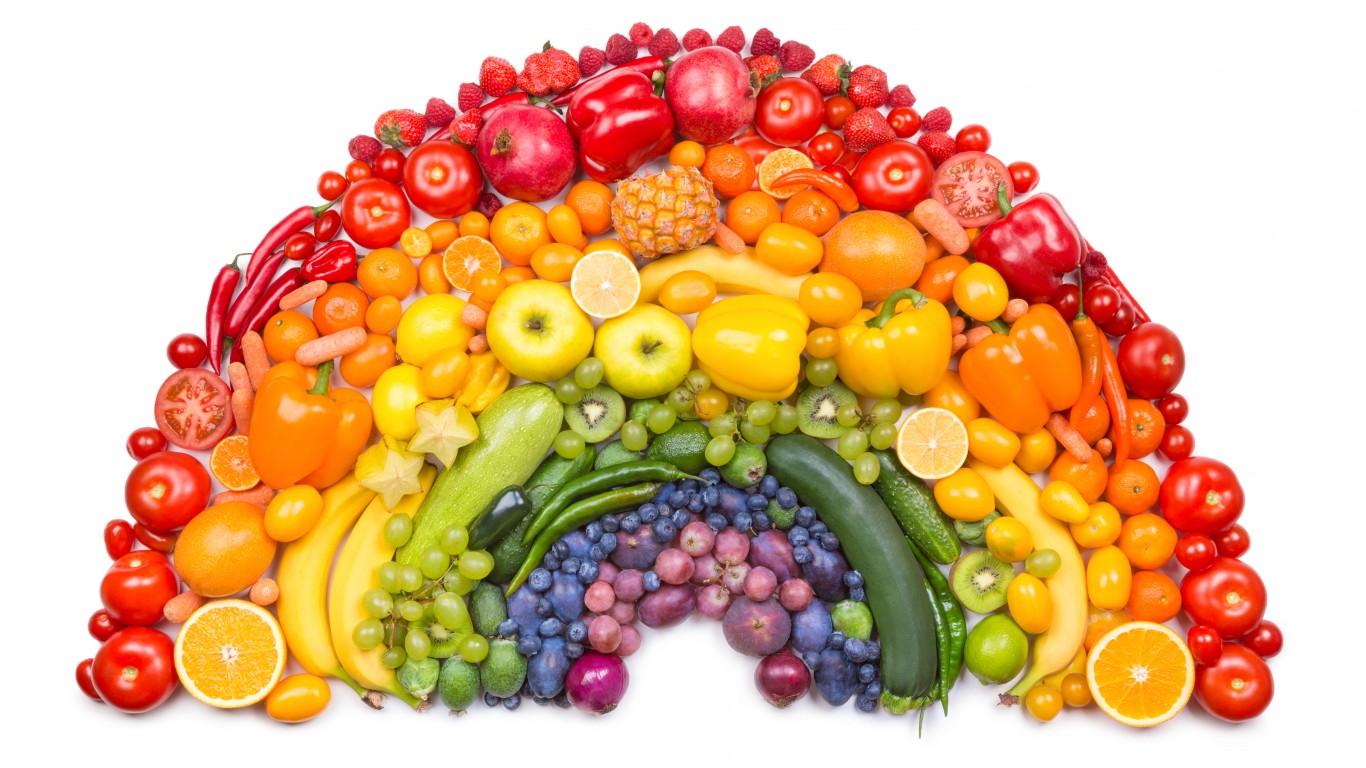
24. Eat the rainbow
Phytonutrients such as beta-carotene and lycopene are often what give fruits and vegetables their distinctive colors and flavors. They may also help prevent disease and have a myriad of other health benefits. A great way to receive the benefits of multiple phytonutrients is to eat fruits and vegetables of all colors.
[in-text-ad-2]

25. Eat whole grains
A diet high in whole grains may reduce the risk of heart disease, diabetes, and premature death. Unlike refined grains whose bran and germ have been removed, whole grains retain their fiber and nutrients. Fiber helps slow the digestion of starch, which prevents rapid spikes in blood sugar. Cooking with unprocessed whole grains such as amaranth, barley, oats, and wild rice can ensure you get more of the nutrients that these grains offer.

26. Reduce red meat consumption, especially processed meats
Although growing evidence suggests that we should limit our intake of red meat — especially processed red meat — many people still eat burgers and sausages. If you’re going to eat red meat, avoid processed and cured meats such as ham, lunch meat, and bacon, as they may be linked to cancer and heart disease. Instead, try lean, unprocessed grass-fed beef, which is higher in omega-3 fatty acids.
While available to relatively few people, wild game such as elk, venison, or bison, which tend to be lower in saturated fats than farm-raised animals, is another healthier option.
[in-text-ad]

27. Don’t diet or think of foods as “off limits”
Studies have shown that restricted eating (dieting) can actually cause people to overeat and focus on their hunger.
It may be about the way diets are framed. A University of Arizona study on food-related warnings showed that dieters who received negative messages about unhealthy food were more likely to want and eat these unhealthy foods. Dieters who received two-sided messages, however, focusing on both the positive and negative aspects of the food, were more likely to choose fewer unhealthy foods.
Instead of thinking of certain foods as off-limits, which may lead to guilt and binging, try reducing portions of unhealthy foods and considering them as an occasional treat.

28. Sub homemade popcorn for potato chips
Chips tend to be higher in fat and calories than popcorn, unless the popcorn is the microwaved, butter-flavored kind. Choose air-popped corn for a whole grain, fiber rich snack that you can eat by the handful. It takes about six cups of popcorn to reach the same number of calories as one cup of chips.

29. Make small changes, one step at a time
Several studies suggest that making small changes in diet and lifestyle may be more effective and sustainable than sudden extreme changes. Instead of attempting a drastic fad diet, set small, realistic goals like eating one extra piece of fruit every day.
Thank you for reading! Have some feedback for us?
Contact the 24/7 Wall St. editorial team.
 24/7 Wall St.
24/7 Wall St. 24/7 Wall St.
24/7 Wall St. 24/7 Wall St.
24/7 Wall St.
